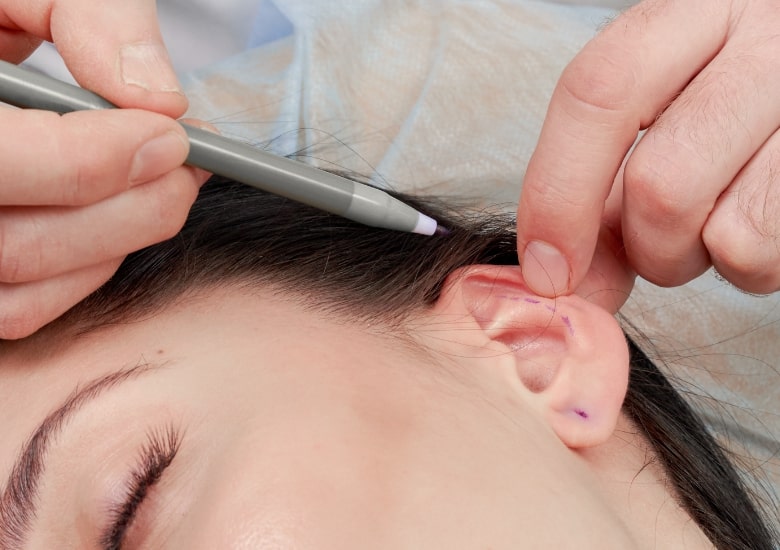Otoplasty
INTRODUCTION TO
Otoplasty
Otoplasty, or Ear Reshaping, is a cosmetic surgery used to alter the ear’s size, position, or shape, in the case they are protruding and unpleasing
aesthetically to the patient. The primary cause of ear protrusion is typically incomplete ear cartilage folding, which gives the appearance that the ear is
protruding. In certain instances, the entire ear cartilage is positioned forward or the earlobe is too big.
It is a surgery that drastically and permanently alters how you look and may have psychological effects, so you should carefully consider your options.
An effective otoplasty procedure should locate the ideal ear position so that the ears don’t protrude or look too pinned back. Additionally, our surgeon will guarantee that the ears are symmetrical to the rest of the head.
It is likely that you’ll be pleased with the outcome if you properly discussed the process and expressed and agreed upon your expectations before to the
operation. Successful otoplasty can increase one’s self-confidence and self-esteem.


Consultation
The patient’s wants and goals will be taken into account during the surgical consultation at our facility. We will collaborate with you to make sure the targeted outcomes are attainable and reasonable. We make sure the patient is entirely at ease with the process by giving them a thorough explanation of what will happen during the treatment.
The doctor will evaluate your overall health, ask about your medical history and describe available options, the steps required, the upcoming treatment, dangers and any potential problems.
In general, quitting smoking several weeks before to any invasive operation is always advised. Additionally, you should let the doctor know about any
prescription drugs you are taking in case he wants you to cease taking certain blood thinners. Your security and happiness are of utmost importance to us, so a great deal of importance is given to the consultation.
Procedure
For the majority of patients, otoplasty can be done while under local anesthetic and with light sedation. General anesthesia can also be utilized,
depending on the patient’s preference. The average otoplasty treatment lasts one to two hours, although each case is unique.
The major surgical goal of ear correction surgery is to decrease the protrusion while simultaneously restoring a normal appearance to the ears. This
goal is accomplished by altering the cartilage’s flexibility beneath the skin, which results in a more ideal form and location. In the gap behind the ears, where any remaining surface scarring will be less noticeable, a roughly 4-5 cm incision is
created in the skin.
On occasion, incisions are made on the outside of the ear, however they are discretely hidden inside the creases or curves. After the ear’s position and shape have been adjusted, the incisions are sutured, and the ears are meticulously filled
with cotton wool and bandaged.
An effective otoplasty procedure should locate the ideal ear position so that the ears don’t protrude or look too pinned back. Additionally, the symmetry of the ears with the rest of the head will be ensured by our surgeon.

Recovery
Resting as much as possible is recommended throughout the healing process after otoplasty. For the first 24-48 hours, a bandage or dressing will be
used to protect the ears. Following surgery, you should anticipate some discomfort, but you will be prescribed medication to help prevent infection and
alleviate pain.
A headband will be fitted for you to wear for about two to three weeks after surgery, especially at night, to prevent you from dragging your ears forward when you roll over in bed. For a few weeks, avoid strenuous activity and close contact with the ears. The surgeon will recommend a specific period when you can resume your normal activities.
The surgeon will take off the bandages a few days following your otoplasty. It’s likely that your ears may be swollen and red, with some bruises, but the
swelling will go down in a few weeks.
Risks
Ear surgery is a delicate yet effective operation. Although they are uncommon, otoplasty does have some potential risks:
- Bleeding
- Infection
- Swelling
- Pain
- Asymmetry of the ears
- Temporary numbness
WE ARE HERE TO HELP YOU
Do you have any questions?
Let our medical experts answer all your inquiries and offer the solution that best fits your cosmetic needs.


